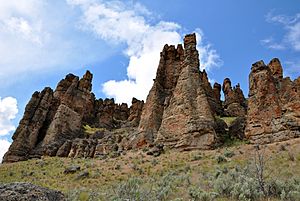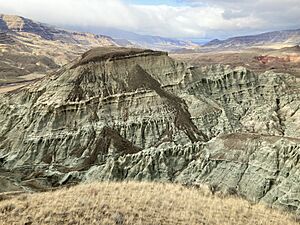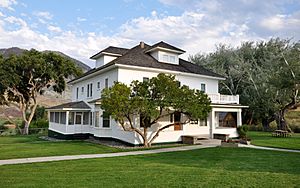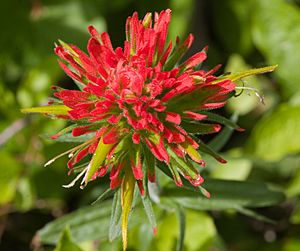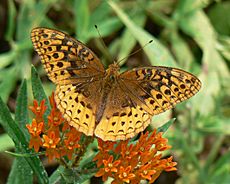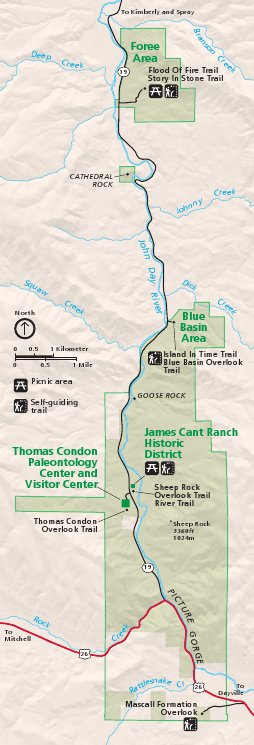John Day Fossil Beds National Monument facts for kids
Quick facts for kids John Day Fossil Beds National Monument |
|
|---|---|
|
IUCN Category V (Protected Landscape/Seascape)
|
|
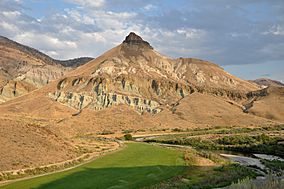
Sheep Rock near sunset
|
|
| Location | Oregon, United States |
| Area | 14,062 acres (56.91 km2) |
| Elevation | 2,244 ft (684 m) |
| Established | October 8, 1975 |
| Named for | the John Day River, which was named for early 19th-century fur trader John Day |
| Visitors | 88,571 in 2020 |
| Governing body | National Park Service |
| Website | |
| Designated: | 1966 |
The John Day Fossil Beds National Monument is a super cool place in central Oregon, USA. It's like a giant outdoor museum filled with amazing fossils! This special park is known for its perfectly preserved layers of ancient plants and mammals. These creatures lived here between 45 million and 5 million years ago.
The monument is managed by the National Park Service. It's made up of three separate areas: Sheep Rock, Painted Hills, and Clarno. Together, these areas cover about 14,000 acres. That's like 10,000 football fields!
You can explore colorful badlands, dry shrublands, and areas along rivers. In 2016, about 210,000 people visited the park. They came to hike, explore, or visit the Thomas Condon Paleontology Center. This center is where scientists study fossils.
Long ago, before European settlers arrived, Native American tribes like the Sahaptin people lived here. They hunted, fished, and gathered food. Scientists have been digging up and studying fossils here since 1864. That's when Thomas Condon, a missionary and amateur geologist, realized how important these fossils were. The area became a National Monument in 1975 to protect these incredible treasures.
The monument is usually dry, with hot summers and cold winters. It has over 80 types of soil, which means many different plants grow here. You can find willow trees near the river, grasses on hills, and even cactus among the rocks. Over 50 types of birds live here, along with large animals like elk and smaller ones like raccoons and coyotes.
Contents
Exploring the Monument's Geography
The John Day Fossil Beds National Monument has three main parts. These are the Sheep Rock, Painted Hills, and Clarno units. They are all in the John Day River basin in central Oregon. The park units have rugged hills, deep valleys, and rocky areas where fossils are found.
The Clarno Unit is the farthest west. It covers about 1,969 acres. You can find it about 18 miles west of Fossil along Oregon Route 218.
The Painted Hills Unit is in the middle. It covers about 3,132 acres. This unit is about 9 miles northwest of Mitchell. It's famous for its colorful hills!
The Sheep Rock Unit is the largest, covering about 8,843 acres. It's along Oregon Route 19 and the John Day River. This unit has many interesting spots like Picture Gorge and the James Cant Ranch Historic District.
The main visitor center is in the Sheep Rock Unit. It's about 122 miles northeast of Bend. The units are spread out, so you'll need to drive to get from one to another. For example, it's about 45 miles from Sheep Rock to Painted Hills.
The John Day River flows through the Sheep Rock Unit. It's a major river in the area. Other smaller creeks also flow through or near the monument's units.
A Look Back in Time: History of the Monument
Long before settlers arrived, Native American tribes lived in this area. These included the Umatilla, Wasco, and Warm Springs tribes. They were hunter-gatherers, meaning they hunted animals and gathered plants for food. They found elk, huckleberries, and salmon here.
Scientists have found 36 ancient sites in or near the monument. These include rock shelters and cairns (piles of stones). The most important are the Picture Gorge pictographs. These are ancient rock drawings in the Sheep Rock Unit. No one knows exactly how old they are, but they are "centuries old."
In the early 1800s, explorers like Lewis and Clark passed by the John Day River. But they didn't explore it much. Later, fur traders like Peter Skene Ogden and John Work traveled through the area.
In the 1840s, many settlers moved west on the Oregon Trail. They were looking for new land and opportunities. After gold was found nearby, some settlers moved to eastern Oregon. They started farms and ranches. Native Americans were eventually moved to reservations.
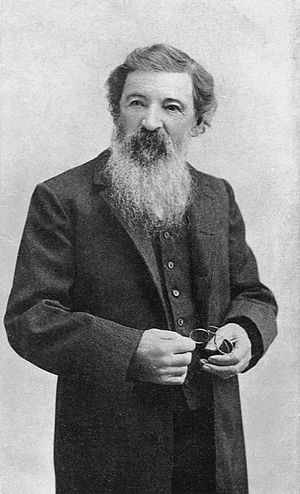
In 1864, soldiers found fossils in a nearby area. They showed them to Thomas Condon, a pastor who loved geology. Condon realized these fossils were very important. In 1865, he found even more fossils near Bridge Creek and Sheep Rock.
Condon's discoveries made the fossil beds famous around the world. Scientists from places like Yale came to study them. By 1900, over 100 articles and books had been written about the John Day Fossil Beds. Condon became Oregon's first state geologist in 1872.
One of the early settlers in the Sheep Rock Unit was Frank Butler in 1877. Later, James and Elizabeth Cant bought land here in 1910. They built a large sheep and cattle ranch.
Scientists like John C. Merriam pushed for the area to be protected. In the 1930s, Oregon started buying land for state parks at Picture Gorge, Painted Hills, and Clarno. These parks later became part of the national monument.
In 1974, the U.S. Congress decided to create the national monument. President Gerald R. Ford signed the law. The monument officially opened on October 8, 1975.
The Cant Ranch House is now a historic site. It has exhibits about the area's history. The Thomas Condon Paleontology Center opened in 2005. It's a museum and visitor center in the Sheep Rock Unit. Here, you can see fossils and watch paleontologists work in their lab.
In 2011, the park added webcams at Sheep Rock. You can watch the paleontology lab and see Sheep Rock live online! The park is also working to be more eco-friendly. They built a nearly carbon-neutral ranger house at Painted Hills.
Ancient Earth: Geology and Paleontology
The John Day Fossil Beds are part of the Blue Mountains area. This area formed millions of years ago. Huge blocks of rock moved and joined the edge of North America.
About 44 million years ago, during the Eocene epoch, volcanoes erupted. They spewed out lava and mudflows. These flows trapped plants and animals in their path. The rocks you see in the Clarno Unit today are from these ancient flows.
The Clarno Formation holds amazing fossils. You can find tropical nuts, fruits, and even palm leaves over 2 feet long! This shows that 50 million years ago, the climate was much warmer and wetter. Large mammals like brontotheres (rhino-like animals) and fierce predators lived here.
After the Clarno volcanoes quieted down, new volcanoes erupted to the west. These "John Day volcanoes" released tons of ash and dust. This ash settled in the John Day basin, burying plants and animals. This created the John Day Strata.
These ash layers are different colors. The bottom layers are red, like those in the Painted Hills. Above that are pea-green clays, then buff-colored layers. The John Day Strata contain fossils of over 100 mammal species! These include ancient dogs, cats, saber-toothed tigers, horses, and camels. You can also find turtles, opossums, and large pigs.
Over 60 plant species are fossilized here, too. These include hydrangea, peas, and mulberry trees. One special plant fossil is the Metasequoia (dawn redwood). People thought this tree was extinct until it was found alive in China!
Later, between 17 and 12 million years ago, huge lava flows covered the area. These flows created the Picture Gorge Basalt, which sits above the John Day Strata.
More ash fell from volcanoes in the Cascade Range. This formed the Mascall Formation. Here, you can find fossils of horses, camels, rhinoceroses, bears, and sloths. These animals lived in open woodlands and grasslands between 15 and 12 million years ago. Fossils of oak, sycamore, and maple trees show the climate was cooler then.
The last major eruption happened about 7 million years ago. This created the Rattlesnake Formation. It holds fossils of mastodons, ancient camels, and early horses. Recently, two fossilized teeth of the earliest beaver were found here! They are about 7 million years old and will be displayed at the Condon Center.
The monument has tons of well-preserved fossils from over 40 million years. These fossils help scientists understand Earth's past climates and how life has changed over time.
Paleontologists at the Condon Center find and collect fossil-bearing rocks. They carefully clean and prepare the fossils in their lab. Then, they store them in special cabinets for research. You can even watch them work through a window at the visitor center!
Weather in the Monument
The monument has a dry climate. This is because mountains block much of the rain. It gets about 9 to 16 inches of rain or snow each year.
Summers are hot, with July and August highs around 86°F (30°C). Winters are cold, with January lows around 24°F (-4°C). The highest temperature ever recorded in Mitchell (near the Painted Hills) was 107°F (42°C). The lowest was -27°F (-33°C)! May is usually the wettest month.
| Climate data for Mitchell, Oregon | |||||||||||||
|---|---|---|---|---|---|---|---|---|---|---|---|---|---|
| Month | Jan | Feb | Mar | Apr | May | Jun | Jul | Aug | Sep | Oct | Nov | Dec | Year |
| Mean daily maximum °F (°C) | 42 (6) |
47 (8) |
54 (12) |
60 (16) |
69 (21) |
77 (25) |
86 (30) |
86 (30) |
77 (25) |
65 (18) |
49 (9) |
42 (6) |
63 (17) |
| Mean daily minimum °F (°C) | 24 (−4) |
27 (−3) |
31 (−1) |
34 (1) |
40 (4) |
47 (8) |
52 (11) |
52 (11) |
44 (7) |
36 (2) |
30 (−1) |
25 (−4) |
37 (3) |
| Average precipitation inches (mm) | 0.87 (22) |
0.65 (17) |
1.00 (25) |
1.22 (31) |
1.65 (42) |
1.13 (29) |
0.61 (15) |
0.65 (17) |
0.67 (17) |
0.80 (20) |
1.12 (28) |
0.99 (25) |
11.36 (288) |
| Source: The Weather Channel | |||||||||||||
Life in the Monument: Flora and Fauna
Flora: Plants of the Park
The monument has over 80 types of soil, which means many different plants can grow here. These plants have adapted to the dry conditions. You'll find willow trees and alders near streams. Shrubs like rabbitbrush and sagebrush thrive in dry areas.
A special black cryptobiotic crust helps the soil. It's made of algae, moss, and bacteria. This crust stops erosion, holds water, and provides nutrients for plants. Some areas, like steep rocky slopes, have very few plants.
Native grasses like basin wildrye and Idaho fescue grow here. But invasive grasses like cheatgrass are a problem. The park tries to manage these to help native plants.
Ponderosa pines grow near water sources. Western junipers also do well in the dry climate. The park sometimes uses controlled fires to help grasses grow and limit the junipers.
Wildflowers bloom mostly in spring and early summer. You might see pincushions and golden bee plant at Painted Hills. At Clarno and Sheep Rock, look for lupines, hedgehog cactus, and Applegate's Indian paintbrush.
Fauna: Animals of the Park
Birds are the easiest animals to spot here! Over 50 species have been seen. Look for red-tailed hawks, great horned owls, and common nighthawks. Geese nest here, and sandhill cranes fly over during migration.
You might also see California quail, chukar partridges, and mourning doves. Near the visitor center, look for rufous hummingbirds and western meadowlarks. On trails, you might spot canyon wrens and mountain bluebirds.
Large animals include elk, deer, cougar, and pronghorn. Near the river, you might find beaver, otter, and raccoons. Coyotes, bats, and badgers also live here. Smaller animals like rabbits, voles, and mice are food for predators.
Bighorn sheep were brought back to the Sheep Rock Unit in 2010. They had disappeared from this area long ago.
Many snakes and lizards live in the monument. You might see alligator lizards and fence lizards. Garter and gopher snakes are common. Rattlesnakes live here too, but they are shy and usually hide.
The park's springs and wet areas have western toads, Pacific tree frogs, and long-toed salamanders. A survey found 55 types of butterflies, including monarchs!
The John Day River is special because it's the longest undammed river that flows into the Columbia River. Chinook salmon and steelhead swim through the monument to lay their eggs upstream. The park is working to restore plants along the river. This helps shade the water and provides homes for insects that fish eat.
Fun Things to Do at the Monument
It's free to enter the park, visitor center, and museums! Trails, overlooks, and picnic areas are open every day during daylight hours. There's no food, places to stay, or gas in the park, and you can't camp here.
The Cant Ranch cultural museum has different hours depending on the season. The Thomas Condon Paleontology Center is open daily from 10 a.m. to 5 p.m. It's closed on federal holidays during the winter (November to February). At the center, you'll find a fossil museum, a theater, a classroom, a bookstore, and restrooms. There's no cell phone service in the monument. Water at picnic areas is turned off in colder months.
The Sheep Rock Unit has eight trails. They range from short walks to a 3-mile hike at Blue Basin. The Painted Hills Unit has four trails, up to 1.5 miles long. At the Clarno Unit, there are three short trails that start near the Clarno Palisades.
Many trails have signs that tell you about the history, geology, and fossils. Some trails, like Story in Stone (Sheep Rock) and Painted Cove (Painted Hills), are wheelchair accessible. Please stay on the trails to protect the fossils and fragile soils.
Park rangers lead fun activities like talks, films, hikes, and ranch tours. They even have astronomy programs at the Painted Hills Unit! These events are free. The park also offers programs and materials for students and teachers.
You can bring your pets, but they must be on a leash. Horses are not allowed on hiking trails. Please do not dig, disturb, or collect any natural resources, including fossils. It's against the rules!
Mountain biking is not allowed on monument land. But you can fish in the John Day River if you have an Oregon fishing license. Rafting is popular on the river, but usually starts outside the monument.
Be careful when visiting! Summers can be very hot, and winter roads can be icy. There are also two types of venomous rattlesnakes and two types of venomous spiders. Watch out for ticks, scorpions, and poison ivy.
See also
- List of fossil sites
- List of national monuments of the United States



